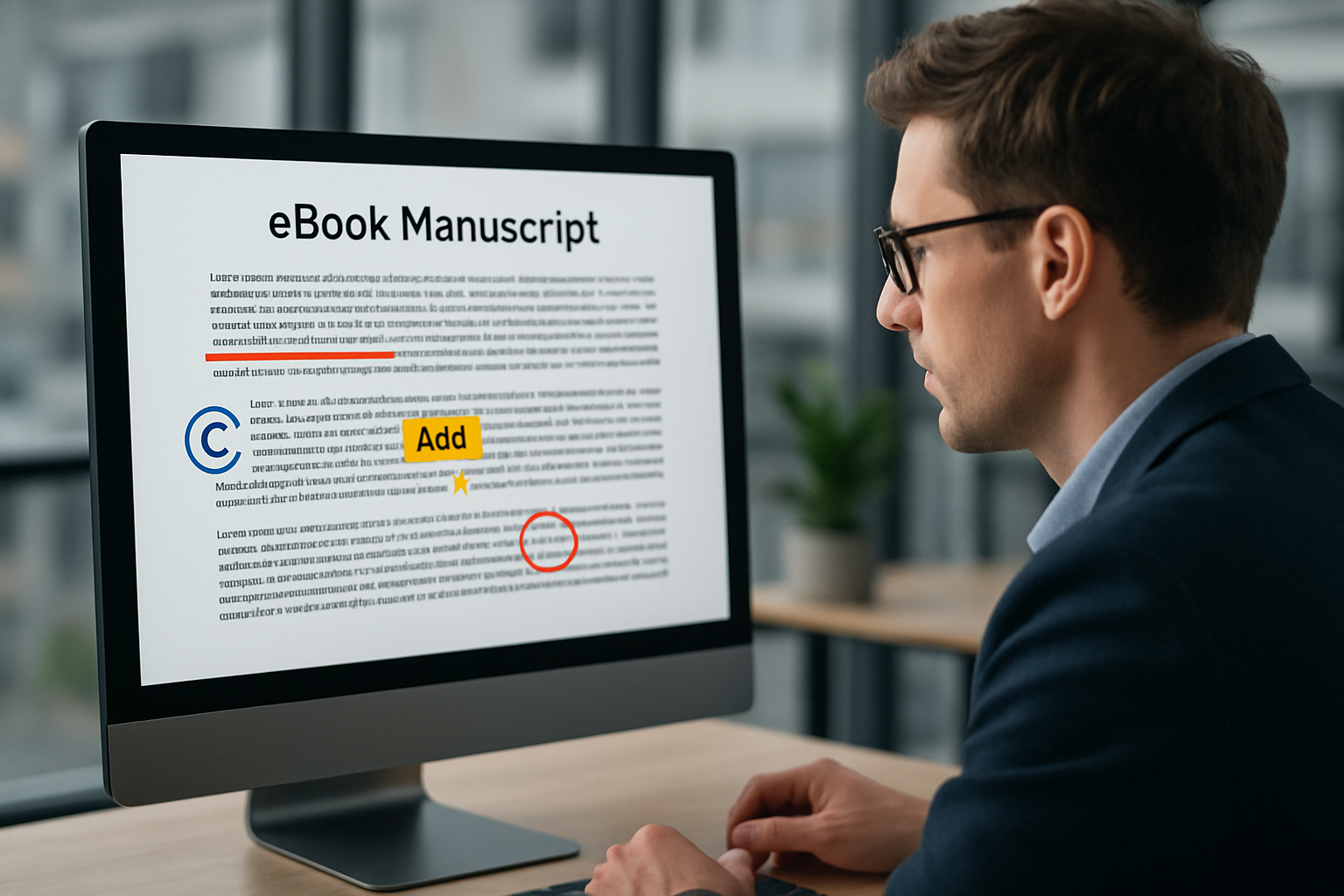In the rapidly evolving world of digital publishing, the journey from penning your first eBook draft to delivering a polished, market-ready product is often underestimated. While authors might celebrate finishing a manuscript, the subsequent phases—especially editing and proofreading—play a critical role in ensuring the content resonates, engages, and convinces readers in 2025’s competitive online market. The mere presence of grammatical errors or disorganized structure can tarnish an author’s credibility and reduce potential reach, especially when millions of eBooks flood platforms daily. Harnessing modern software like Scrivener, Vellum, Adobe, and Calibre, alongside editing platforms such as Reedsy, Hemingway App, ProWritingAid, Microsoft Word, and Google Docs, authors have unprecedented tools at their disposal. Yet, the essence of taking full advantage of these resources lies not just in mastering writing but in meticulous editing.
Editing is far more than just correcting typos; it’s about refining content, enhancing clarity, sharpening narrative flow, and aligning the manuscript with reader expectations. This phase transforms a rough draft into a compelling and professionally credible eBook. As publishing platforms become more accessible and the demand for quality content intensifies, understanding the importance of editing ensures authors maximize their eBook’s success potential. For instance, authors aiming to optimize their eBook’s SEO for visibility must refine their manuscripts carefully, a process intricately tied to editing strategies that go beyond language—such as structuring content for internet algorithms and audience engagement.
In addition to the strategic use of editing software, the human element remains indispensable. Engaging a professional editor might seem costly but is often a worthy investment, especially for building a brand and trust with readers. Still, with the right self-editing techniques, authors can deeply understand and improve their writing, adding value before passing it on for professional polishing. Navigating this balance between cost, software utility, and human insight is crucial in 2025’s eBook landscape.
The Critical Role of Editing in eBook Creation: Ensuring Professionalism and Clarity
Editing is often misunderstood as just polishing language or correcting small mistakes, but it is the backbone of producing a professional eBook. Without thorough editing, even the most insightful content risks being lost in translation or overshadowed by simple errors. When an eBook lacks precision in grammar, punctuation, or style, it sends a message of unprofessionalism, deterring readers and undermining the author’s credibility.
Editing enhances an eBook by:
- Eliminating grammatical and spelling errors: These mistakes distract readers and can signal carelessness.
- Improving structure and pacing: Sometimes chapters or sections need to be rearranged or omitted to strengthen flow.
- Clarifying ideas: Editing ensures arguments or storylines are coherent and engaging.
- Adapting the tone and style: Matching reader expectations with appropriate voice and language is key.
For instance, a complex technical eBook created using Adobe InDesign or authored in Microsoft Word can benefit significantly from structural edits that improve readability. Likewise, narrative fiction drafted in Scrivener demands careful pacing and character consistency, achievable only through multiple rounds of editing. Utilizing an editing software like Hemingway App or ProWritingAid flags complex sentences, passive voice, or overused words, helping the author streamline the text without losing their distinctive voice.
Editing in practice also includes:
| Editing Aspect | Purpose | Tools & Methods |
|---|---|---|
| Structural Editing | Organizes content and enhances narrative flow | Scrivener, manual outline reviews |
| Copyediting | Corrects grammar, punctuation, and style | Microsoft Word, Grammarly |
| Fact-Checking | Verifies data accuracy for nonfiction | Manual research, online databases |
| Proofreading | Final check for typos and formatting consistency | Adobe PDF review, Calibre formatting tools |
Evidently, editing is integral from macro-revisions (like reconnecting narrative arcs) to micro-details such as consistent punctuation. Many authors feel temptations to skip steps due to time constraints, yet this risks alienating readers and jeopardizing the marketing efforts critical in today’s self-publishing platforms described at side-business.com.

Strategic Self-Editing Techniques: Making the Most of Available Tools and Time
Self-editing remains a cornerstone particularly for independent authors and those focused on managing budgets. With professional editing services ranging significantly in price—as high as several thousand dollars—many eBook creators in 2025 rely on systematic self-editing before engaging professionals.
Key steps for effective self-editing include:
- Allowing the manuscript to rest: Authors should distance themselves from their first draft for a few weeks to build objectivity and fresh perspective.
- Identifying major inconsistencies: Reading the manuscript without distraction helps spot contradictions, missing information, or logical fallacies. This aligns with the advice to “focus on the forest, not the trees.”
- Fact-checking: Especially for nonfiction, verifying statistics, names, and references is essential to maintain credibility and trust.
- Grammatical and stylistic refinement: Utilizing platforms like ProWritingAid, Hemingway App, or Microsoft Word grammar check helps identify awkward phrasing and common errors.
- Proofreading: This final sweep focuses on catching minor typos, punctuation, and formatting inconsistencies, often supported by tools like Calibre or Adobe Acrobat.
- Humanizing the text: Editing to include an authentic voice, anecdotes, emotional layer, and humor creates connection and engagement.
Incorporating these into a clear process prevents rushed or incomplete edits. For instance, using Scrivener for chapters’ rearrangement supports smoother narrative flow, whereas Vellum’s elegant eBook formatting ensures the final file is visually appealing on platforms like iBooks Author.
Here’s a concise checklist summarizing these essential self-editing elements:
| Task | Purpose | Recommended Tools |
|---|---|---|
| Manuscript Rest | Gain objective perspective | None needed |
| Major Flaws Identification | Spot structural issues | Manual review |
| Fact-Checking | Confirm accuracy | Online databases, research |
| Grammar & Style Editing | Correct language flaws | Grammarly, ProWritingAid, Hemingway App |
| Proofreading | Catch typos and format issues | Calibre, Adobe Acrobat |
| Humanization | Engage readers emotionally | Manual writing approach |
In our digital era, harnessing AI-enhanced tools for editing, like Grammarly which received a whopping $1 billion AI investment, bridges the gap between human effort and technological assistance, increasing both precision and efficiency. For authors who want additional guidance, resources exploring techniques around engaging ebook writing and creating compelling ebook content provide valuable insights.
Collaboration with Professional Editors: When and How to Invest for Maximum Return
While self-editing is crucial, there comes a moment when professional intervention substantially benefits an eBook. Freelance editors bring fresh eyes, experience, and objective critique that can elevate a manuscript beyond what self-editing can achieve. However, the investment can be costly, with rates generally $35 to $75 per hour.
Authors aiming to pursue professional editing should consider these factors:
- Complete your own rounds first: Presenting your best possible draft saves time and money during professional editing.
- Define your goals: Specify whether you want developmental editing focusing on structure or copyediting that polishes grammar and style.
- Set expectations for feedback: Accepting criticism constructively allows your eBook to transform into a superior final product.
- Research the editor’s expertise: Different genres and styles demand editors with appropriate backgrounds.
- Budget accordingly: Considering the financial investment is essential, but so is weighing the potential impact on sales and reception.
The table below outlines key types of professional editing and their focus:
| Editing Type | Description | When to Use |
|---|---|---|
| Developmental Editing | Refines big-picture aspects like plot, pacing, and character development. | Early drafts ready for structural improvement. |
| Copyediting | Fixes grammar, punctuation, and adherence to style guides. | Near-final drafts requiring polish. |
| Proofreading | Final review ensuring no residual typos or formatting errors. | Pre-publication phase. |
Leveraging editing tools, such as Reedsy’s marketplace for connecting with professionals or using Google Docs for transparent editorial collaboration, streamlines the process. Additionally, choosing platforms such as Vellum helps incorporate professional formatting standards required by distributors, including iBooks Author or Amazon Kindle Direct Publishing, which affect reader experience.
For authors uncertain about investing in editing services, exploring industry strategies like maximizing profits through eBook bundles or leveraging SEO editing strategies may provide financial incentives for allocating budget towards quality editing.
The Essential Final Step: Proofreading and Formatting to Ensure a Polished eBook Release
After extensive editing, proofreading stands as the final gatekeeper before publication. This meticulous phase roots out any remaining errors—spelling, punctuation, formatting—that could damage the reader’s experience or brand reputation. Proofreading also ensures your eBook looks professional across all devices and platforms.
Important proofreading considerations include:
- Using multiple modalities: Reading the text aloud or employing text-to-speech software uncovers awkward phrasing and rhythm issues.
- Consistent formatting: Uniform paragraph spacing, font size, and chapter headings elevate reader engagement.
- Compatibility check: Ensuring the eBook displays correctly in formats like EPUB or MOBI used by iBooks Author and Calibre exporters.
Careful formatting often utilizes tools such as Vellum’s sleek templates that facilitate beautiful layouts meeting industry standards. Avoiding poor formatting errors—such as inconsistent margins or random hyphenations—is crucial, as these detract from the reading experience.
Alongside proofreading, polishing your cover design and metadata impacts discoverability and professionalism. Services and tips for creating eye-catching ebook covers contribute immensely to market traction.
| Proofreading Task | Purpose | Recommended Tool |
|---|---|---|
| Spelling and Typo Check | Eliminate careless errors | ProWritingAid, Grammarly |
| Stylistic Consistency | Ensure uniform voice and tone | Hemingway App |
| Format Verification | Guarantee professional layout | Vellum, Calibre |
| Device Compatibility Test | Cross-platform readability | Kindle Previewer, iBooks Author Preview |

Making Your eBook Thrive Post-Editing: Visibility, Marketing, and Reader Engagement
The editing process is a cornerstone, but an eBook’s success in 2025 also depends on subsequent strategies to enhance its visibility and reader engagement. Editing optimizes the content for SEO and readability, crucial for discoverability on eCommerce sites and search engines. Integrating keywords effectively—an element addressed during editing—helps attract and retain your ideal audience, as detailed in resources like side-business.com’s guide to eBook SEO strategies.
Marketing considerations benefiting from thorough editing include:
- Creating captivating series: Structured, well-edited series can sustain reader interest over multiple volumes, increasing lifetime sales as explored in writing captivating ebook series resources.
- Crafting compelling calls to action: Clear, concise language encourages reader interaction and encourages purchases or subscriptions.
- Leveraging affiliate marketing tools: Edited content paired with affiliate marketing strategies can maximize profits, a topic found in best tools for affiliate marketers in 2025.
- Bundling and promotions: Edited eBooks paired in bundles can boost sales volume and profitability.
In sum, the editing process doesn’t stop at manuscript perfection; it creates the foundation for future marketing success. Authors who invest time and resources in editing and proofreading are better positioned to capitalize on the digital marketplace.
Frequently Asked Questions on Editing eBooks
- Q: How long should I wait before starting to edit my first draft?
A: Ideally, take at least two to four weeks to distance yourself from the manuscript for a fresh and objective review. - Q: Can self-editing replace professional editing?
A: While self-editing is invaluable, professional editing offers an expert perspective that greatly enhances quality, especially before publication. - Q: What are the best tools for editing an eBook?
A: Popular tools include Grammarly, ProWritingAid, Hemingway App, Scrivener, and formatting tools like Vellum and Calibre. - Q: How important is proofreading compared to editing?
A: Proofreading is the final crucial step to catch lingering errors and ensure polished formatting; neglecting it undermines all prior editing efforts. - Q: How do I choose the right editor for my eBook?
A: Look for editors experienced in your genre with good references, and clarify your editing needs upfront.


